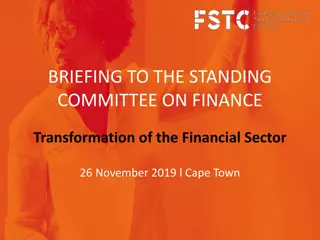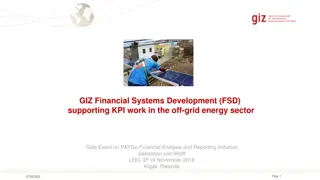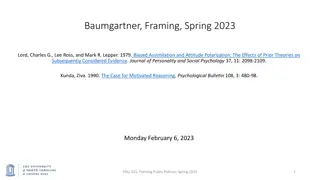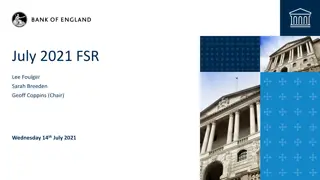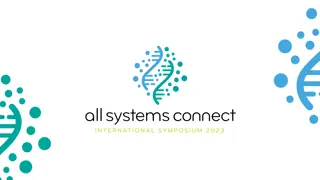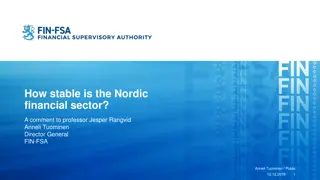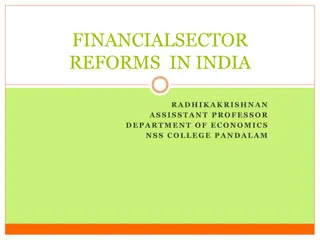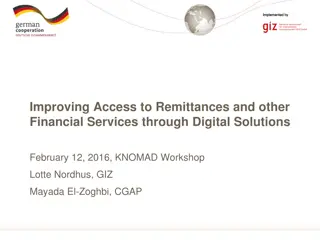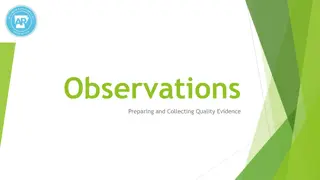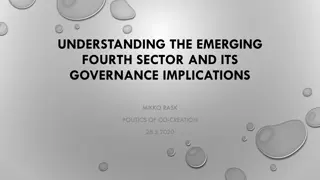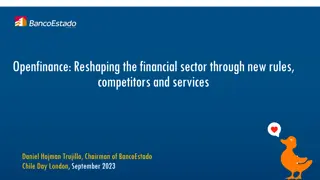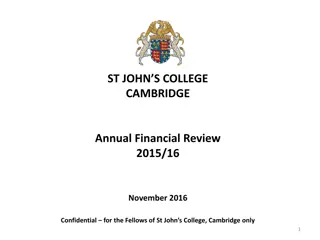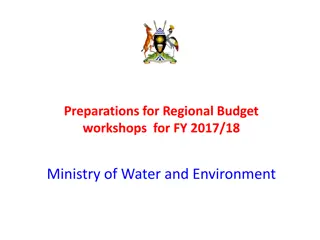Financial Sector Development: Evidence and Strategies
Reviewing the evidence on financial sector development reveals that stable institutions, effective policies, and proper support functions are crucial for financial deepening, inclusion, and long-term finance. Strong evidence suggests that macro stability, liberal policies, and efficient regulations play key roles in financial development. Additionally, support functions such as credit bureaus and collateral registries enhance lending efficiency. The impact of financial development on economic growth, poverty reduction, and stability is evident through various pathways and outcomes.
Download Presentation

Please find below an Image/Link to download the presentation.
The content on the website is provided AS IS for your information and personal use only. It may not be sold, licensed, or shared on other websites without obtaining consent from the author. Download presentation by click this link. If you encounter any issues during the download, it is possible that the publisher has removed the file from their server.
E N D
Presentation Transcript
What Works for Financial Sector Development? A review of the evidence DIIS December 2nd2014
FSD: ToC - Overview Policies & Institutions Financial Deepening Support Functions Long term Finance Financial Inclusion Poor, marginalised able to save/ invest/insure Reduced risk of financial shocks Better info., security to lend Long term savings=investing Higher private investment Outcome Stable, deep & inclusive financial system Pathways out of poverty, avoid poverty traps Financial depth Financial stability Higher investment Impact Sustained economic growth, poverty reduction
Evidence: policies, institutions Policies, institutions=stability financial development Financial shocks=recessions, increased poverty. Strong evidence, 2009, Asian crisis 30% variation in rates of poverty reduction attributable to cross-country variation in financial development Strong evidence that macro stability, liberal policies and effective prudential regulation lead to financial . But liberalisation not leading to lower spreads. Strong evidence that creditor rights, contract enforcement and bankruptcy laws lead to financial development Essential for Systems Approach
Results Chain: Support Functions Support Functions for Stability, Deepening & Inclusion
Evidence: support functions Support functions=better information security of lending efficient infrastructure skilled workforce Good evidence that credit bureaus, collateral registries contribute to greater lending. Good evidence that payments infrastructure, inter-operability, rating systems lead to efficiency But supply driven. Information on demand can make a difference (low cost accounts, savings) but is woefully inadequate. Many products fail Many programmes fcous on skills but lack of good evidence on outcomes Enabler of Systems Approach
Evidence: Long Term Finance Demigurc-Kunt and Levine (1996) Financial development leads to increase in the assets of the banking system and non-bank financial institutions Financing for infrastructure shown to have good results and some evidence to support impact investment But macro evidence of link between stock markets and growth is weak. Micro Evidence shows link to credit and growth but not conclusive. Evidence for pensions and insurance weak; many studies show reverse causality. Micro insurance is growing rapidly but results not as expected and some products have proved expensive failures. Impact may be on FSD not growth or poverty. More research needed.
Evidence: Financial Deepening Private credit/GDP = higher investment consumption smoothing investment in human capital Causality of deepening to growth has been proven robustly. Strong evidence for depth and growth in country. But pathways not well understood. Positive links with reducing inequality, hunger, resilience to shocks and poverty but transmission pathways not well researched. Link between A2F and SME growth strong but not panacea, works with transformative enterprises only. Impact of deepening on growth & poverty is robust
Evidence: Inclusion Weaker macro evidence in support of inclusion. Linked to depth and this does reduce inequality/ poverty. . BUT still important for poor: to support livelihoods/ diversification, finance health,/education, smooth consumption, promote resilience. Financial literacy only works at teachable moments, allied to products. Past focus on mircocredit. But better understanding now that poor need savings, insurance, payments. Despite financial diaries, dont know much about demand.
Evidence: Microfinance Microcredit No miracle, used for consumption, modest benefits but essential for entrepreneurs Limitations of one-size fits all. Small sums, not tailored to need. Works better when vary terms. Gap between MFIs, banks. Stronger evidence for micro savings & smoothing consumption. Mirco insurance very little evidence. Little demand. ICT no evaluations done. But reduces costs and increases outreach Need for further research


